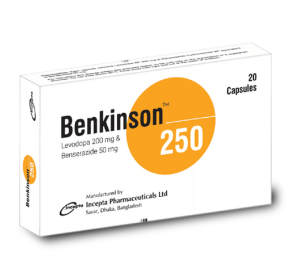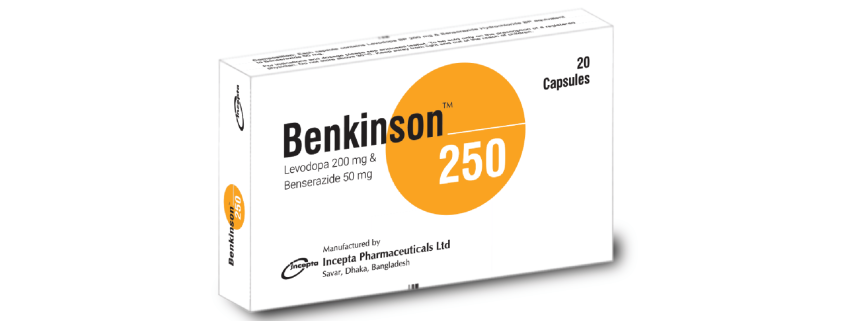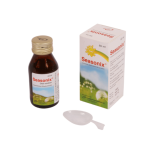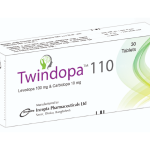Benkinson(Levodopa & Benserazide Capsule)

Therapeutic Group: Anti Parkinsonian Agent
Presentation
BenkinsonTM 62.5: Each capsule contains Levodopa BP 50 mg and Benserazide Hydrochloride BP equivalent to Benserazide 12.5 mg.
BenkinsonTM 125: Each capsule contains Levodopa BP 100 mg and Benserazide Hydrochloride BP equivalent to Benserazide 25 mg.
BenkinsonTM 250: Each capsule contains Levodopa BP 200 mg and Benserazide Hydrochloride BP equivalent to Benserazide 50 mg.
BenkinsonTM CR 125: Each controlled release capsule contains Levodopa BP 100 mg and Benserazide Hydrochloride BP equivalent to Benserazide 25 mg.
Description
Levodopa-Benserazide capsule is an anti-Parkinson’s agent. Levodopa (dopamine precursor) is used as a prodrug to increase dopamine levels since it is able to cross the blood brain barrier whereas dopamine itself cannot. Once levodopa has entered the central nervous system, it is metabolized to dopamine by aromatic L-amino acid decarboxylase. After administration, levodopa is rapidly decarboxylases to dopamine in extra-cerebral as well as cerebral tissues. As a result, most of the levodopa administered is not available to the basal ganglia and the dopamine produced peripherally frequently causes unwanted side effects. It is therefore particularly desirable to inhibit extra-cerebral decarboxylation of levodopa. This can be achieved by simultaneous administration of levodopa-benserazide capsule, a peripheral decarboxylase inhibitor. Levodopa- benserazide capsule is a combination of these two substances in a ratio of 4:1 – this ratio having proved optimal in clinical trials and therapeutic use – and is just as effective as large doses of levodopa given alone.
Indications
Levodopa-Benserazide (immediate release capsule) is indicated for the treatment of all forms of Parkinson’s syndrome with the exception of medicine-induced Parkinsonism. On the other hand, controlled release capsule indicated for patients presenting with all types of motor fluctuations in response, especially those related to fluctuations in plasma levels (i.e. “peak dose dyskinesia” and “end of dose deterioration”) and for better control of nocturnal symptoms.
Dosage & Administration
Levodopa-Benserazide is a medication used to treat Parkinson’s disease. The dosing recommendations for immediate release (IR) and controlled release (CR) capsules are as follows:
Immediate release capsule (IR):
Patients not presently receiving levodopa
Patients previously on levodopa monotherapy
Patient previously on other levodopa/dopa decarboxylase combination therapy
Initial dose:
Levodopa-Benserazide (50+12.5) 62.5 mg, 1-2 times/day
Levodopa-Benserazide (50+12.5) 62.5 mg, 3-4 times/day
Levodopa-Benserazide (100+25) 125 mg, 3 times/day
Maintenance:
Gradually increase by Levodopa-Benserazide (50+12.5) 62.5 mg daily, every 3-4 days according to response.
Maximum dose is 6 capsules/day
Controlled release capsule (CR):
Parkinson’s disease with motor fluctuation
Patients not presently receiving levodopa
Patients previously on levodopa-Benserazide immediate release preparation
Elderly Early Stage
Adult Advance stage
Initial dose:
1 capsule of Levodopa-Benserazide (100+25) 125 mg controlled release capsule, 3 times/day
Initially, dose should substitute every 100 mg of levodopa with 1 controlled-release capsule, given at the same dosage frequency as before. Increase every 2-3 days according to response.
Special populations:
Patients with renal impairment: No dose reduction of Levodopa-Benserazide is considered necessary in case of mild or moderate renal insufficiency.
Patients with hepatic impairment: The safety and efficacy of Levodopa-Benserazide have not been established in patients with hepatic impairment.
It is important to follow the dosing instructions provided by a healthcare provider and report any side effects or concerns promptly.
Side Effects
Anxiety, appetite decreased, arrhythmia, depression, diarrhea, hallucination, movement disorders, nausea, postural hypotension, sleep disorders, altered taste, vomiting, leucopenia etc.
Precautions
Cushing’s syndrome, diabetes mellitus, endocrine disorders, history of convulsions, history of myocardial infarction with residual arrhythmia, history of peptic ulcer, hyperthyroidism, osteomalacia, pheochromocytoma, psychiatric illness, severe cardiovascular disease, severe pulmonary disease, susceptibility to angle-closure glaucoma.
Use in Pregnancy & Lactation
Pregnancy: Pregnancy – Category B3. Levodopa-Benserazide capsule is contraindicated during pregnancy and in women of childbearing potential in the absence of adequate contraception. If pregnancy occurs in a woman taking Levodopa-Benserazide capsule, the medicine must be discontinued.
Lactation: The safe use of Levodopa-Benserazide capsule during lactation has not been established. Use in Children
Levodopa-Benserazide capsule is contraindicated in patients less than 30 years old.
Drug Interaction
Neuroleptics, opioids and antihypertensive medications containing reserpine inhibit the action of levodopa and benserazide capsule. It should not be administered concomitantly with sympathomimetic (agents such as adrenaline, noradrenaline, isoproterenolor amphetamine which stimulate the sympathetic nervous system) as levodopa may potentiate their effects. Should concomitant administration levodopa- benserazide capsule prove necessary, dose surveillance of the cardiovascular system is essential and the dose of the sympathomimetic agents may need to be reduced. Concomitant administration of antipsychotics with dopamine-receptor blocking properties, particularly D2-receptor antagonists might antagonize the antiparkinsonian effects of levodopa-benserazide capsule. Levodopa-benserazide capsule should be discontinued 12-48 hours before surgical intervention requiring general anesthesia with halothane as fluctuations in blood pressure and/or arrhythmias may occur.
Over Dose
Monitor the patient’s vital signs and institute supportive measures as indicated by the patient’s clinical state. In particular patients may require symptomatic treatment for cardiovascular effects (e.g. anti-arrhythmics) or central nervous system effects (e.g. respiratory stimulants, neuroleptics). In addition, for the controlled release formulation further absorption should be prevented using an appropriate method.
Storage
Do not store above 30 °C. Keep away from light and out of the reach of children.
Commercial Pack
BenkinsonTM 62.5: Each box containing 3 blister strips of 10 capsules.
BenkinsonTM 125: Each box containing 3 blister strips of 10 capsules.
BenkinsonTM 250: Each box containing 2 blister strips of 10 capsules.
BenkinsonTM CR 125: Each box containing 2 blister strips of 10 capsule.



